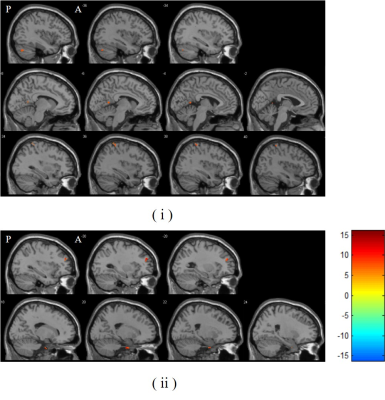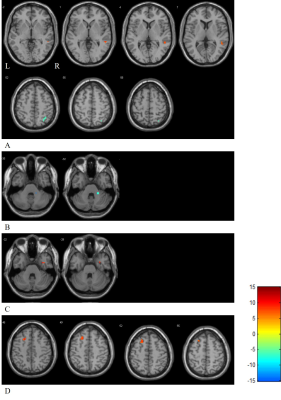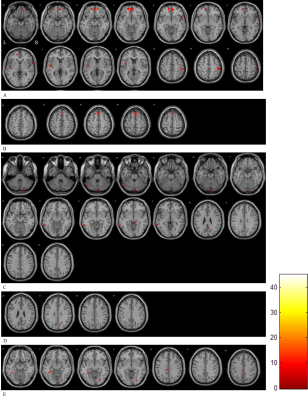3163
Changes in Gray Matter Volume and Functional Connectivity of Obese Females with Acupuncture and Diet Control Therapy: Placebo Effect or Not?1Human Phenome Institute, Fudan University, Shanghai, China, 2Institute of Science and Technology for Brain-Inspired Intelligence, Fudan University, Shanghai, China, 3Department of Nutrition, Zhongshan Hospital, Fudan University, Shanghai, China, 4Center of Clinical Epidemiology and Evidence-based Medicine, Fudan University, Shanghai, China, 5Philips Healthcare, Shanghai, China, 6Department of Endocrinology, Zhongshan Hospital, Fudan University, Shanghai, China
Synopsis
Weight loss is a stressful process for obese women, and effects on their physiology and psychology vary from different methods to lose weight. Acupuncture is a relatively easy and effective way, but its mechanism is still unclear. To investigate these phenomena, 16 obese females were recruited to participate in this MRI study. Our results show that the weight loss methods of acupuncture and diet control increase gray matter volume in different regions, and the influence of acupuncture for functional connectivity might be lighter, which is likely to reveal the acupuncture principles and the psychological impact on patients.
Introduction
With social development and aesthetic changes, obesity has increasingly worsened the self-cognition and psychological impact for women. Acupuncture is especially suitable for particular populations such as pregnant women and adolescents due to its remarkable, long-lasting curative effects but no side effects. According to previous studies, acupuncture of Chinese medical science has achieved success in weight control, and is likely to have a certain interaction with unknown changes in brain function, but it is still regarded as a "placebo effect" in current medical opinion. Therefore, we use voxel-based morphometry (VBM) analysis and resting-state functional magnetic resonance imaging (rs-fMRI) analysis, through setting a control group with diet control, to investigate the unique effects of acupuncture on weight loss.Materials and Methods
We recruited eight obese females (age 40.3 ± 14.0, baseline BMI 30.2 ± 2.5) of Chinese ethnicity with acupuncture and eight obese females (age 38.4 ± 11.9, baseline BMI 30.8 ± 2.3) with diet control therapy to lose weight in order to participate in this brain structural and functional MRI research. Acupuncture frequency was 3 times/week and lasting 40 minutes, and the location with 0.30*50 mm needles is bilateral Stomach9 (ST9), ST10, ST21, ST25, ST29, ST36, ST40 and ST44 1 during the 4 weeks’ therapy. The participants received twice scans before and after the weight loss therapy (mean time between scans: 41.95 ± 9.65 days). All scans were performed on a 3.0 T MRI scanner (GE, DISCOVERY MR750 system) at Shanghai Zhongshan Hospital (Fudan University, Shanghai, China). The functional images covering the whole brain were collected using an echo-planar imaging (EPI) sequence with following acquisition parameters: TR = 2000 ms, TE = 30 ms, 128 × 128 matrix, number of slices = 30, slice thickness = 4.0 mm. After the EPI scan, anatomical images were collected using a high-resolution T1-weighted 3-dimensional magnetization-prepared rapid acquisition gradient-echo (MPRAGE) pulse sequence with the following acquisition parameters: TR = 8.24 ms, TE = 3.22 ms, 256 × 256 matrix, number of slices = 164, slice thickness = 1.0 mm. T1-weighted data were analyzed with VBM using statistical parametric mapping. Subsequently, based on the statistical results of VBM, we drew five spherical regions of interest (ROI) with a radius of 6mm as seed points, performing a functional connectivity (FC) analysis with the whole brain voxels to investigate the relationship between structural changes and functional connections caused by the different weight loss therapies for females.Results
The results reveal the grey matter volume (GMV) in cerebellum crus 1 (as ROI 1), posterior cingulate (as ROI 2) and posterior center gyrus (as ROI 3) are significantly increased after acupuncture, whereas in uncus (as ROI 4) and middle frontal gyrus (as ROI 5) are increased after diet control therapy (Figure 1). Figure 2 shows that in middle temporal gyrus, fusiform gyrus and frontal lobe, FC with ROIs of acupuncture group are increased significantly, while in cerebellum anterior lobe, superior parietal lobule, FC with ROIs are decreased. And in many regions of frontal lobe, temporal lobe, occipital lobe, limbic lobe and cerebellum, the FC with ROIs of control group are significantly only increased (Figure 3).Discussion
The GMV results show that the functional region of sense of smell has changed for females of diet control, and the reading functional region might also be influenced, which caused the great discrepancy in mental and cognitive functional regions through FC results, even if in a short period there was no external changes in appearance for weight loss. However, we find that the females with acupuncture have grey matter changes in regions of visceral activity, sleep quality 2 and somatosensory, and there are fewer FC changes with the regions related to memory and emotion compared with the controls. In addition, a special GMV change of cerebellum is deserved to discuss, whether in the region of motor or social function 3. Therefore, compared with diet control, it is possible that acupuncture, as a traditional Chinese treatment, actually promote the physical function for the female patients in the process of weight loss, and the psychological burden is lighter.Conclusion
Our findings can provide a basis for the theories of acupuncture in Chinese medical science and the psychological impact of weight loss on patients. Furthermore, our future work will focus on these significantly changed brain functional regions to investigate the idiographic effects of acupuncture on human brain function.Acknowledgements
This work was sponsored by the Special Project of Integrating Traditional Chinese and Western Medicine in Shanghai General Hospital from the Shanghai Municipal Health Commission and Shanghai Municipal Administrator of TCM [ZY(2018-2020)-FWTX-3019 to Yan HM] and the Guidance Project from Shanghai Science and Technology Commission [19401931100 to Wang XY].References
1. World Health Organization. A proposed standard international acupuncture nomenclature: Report of a WHO Scientific Group. Geneva, Switzerland: World Health Organization; 1991.
2. Anna H, Ambra S, Elisabeth B, et al. Gray Matter Abnormalities of the Dorsal posterior Cingulate in Sleep Walking. Sleep Medicine. 2017;36: 152-155.
3. Van Overwalle F, Manto M, Cattaneo Z, et al. The posterior crus II cerebellum is specialized for social mentalizing and emotional self-experiences: a meta-analysis. Social Cognitive and Affective Neuroscience. 2020;15(9): 905–928.
Figures


